1990 VOLKSWAGEN CORRADO sensor
[x] Cancel search: sensorPage 590 of 906
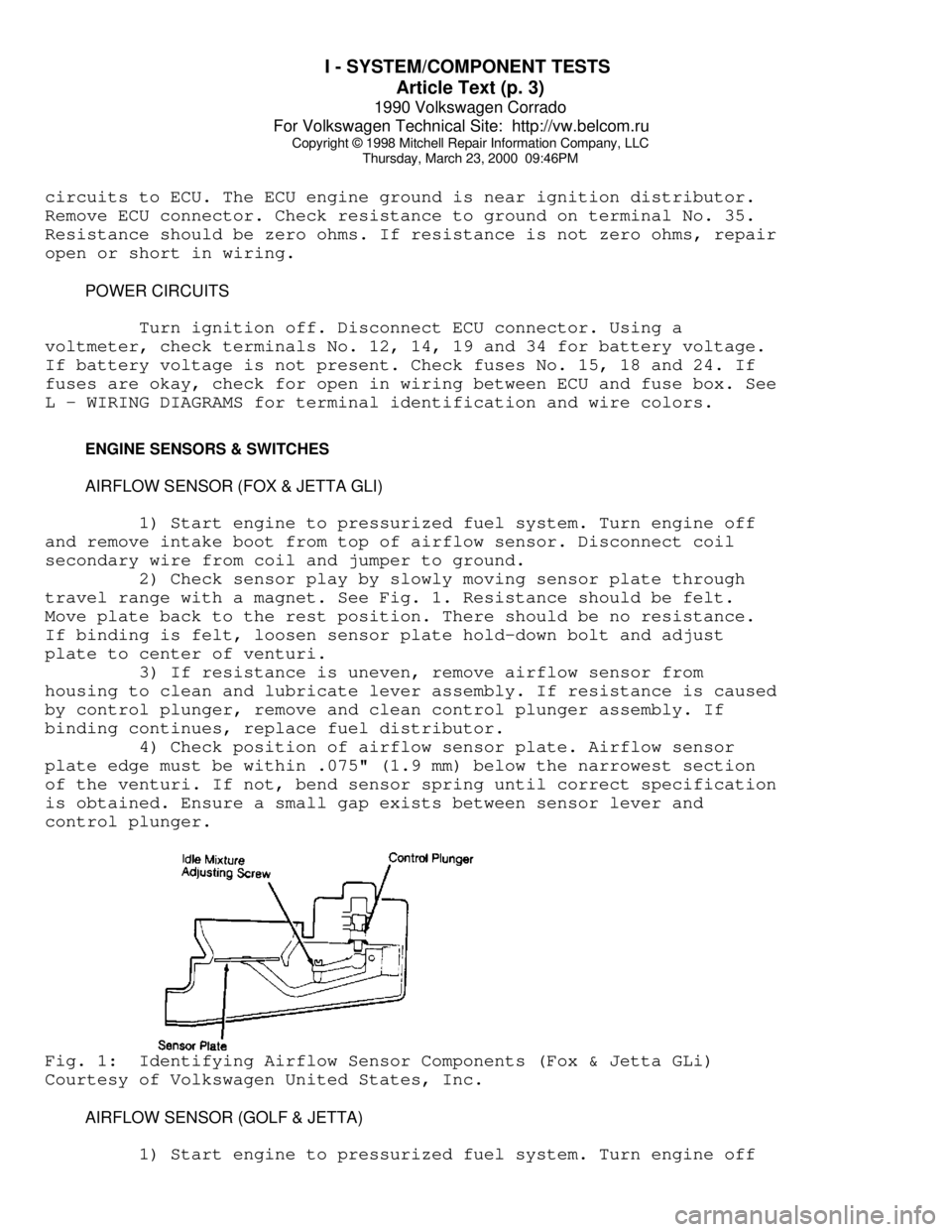
I - SYSTEM/COMPONENT TESTS
Article Text (p. 3)
1990 Volkswagen Corrado
For Volkswagen Technical Site: http://vw.belcom.ru
Copyright © 1998 Mitchell Repair Information Company, LLC
Thursday, March 23, 2000 09:46PM
circuits to ECU. The ECU engine ground is near ignition distributor.
Remove ECU connector. Check resistance to ground on terminal No. 35.
Resistance should be zero ohms. If resistance is not zero ohms, repair
open or short in wiring.
POWER CIRCUITS
Turn ignition off. Disconnect ECU connector. Using a
voltmeter, check terminals No. 12, 14, 19 and 34 for battery voltage.
If battery voltage is not present. Check fuses No. 15, 18 and 24. If
fuses are okay, check for open in wiring between ECU and fuse box. See
L - WIRING DIAGRAMS for terminal identification and wire colors.
ENGINE SENSORS & SWITCHES
AIRFLOW SENSOR (FOX & JETTA GLI)
1) Start engine to pressurized fuel system. Turn engine off
and remove intake boot from top of airflow sensor. Disconnect coil
secondary wire from coil and jumper to ground.
2) Check sensor play by slowly moving sensor plate through
travel range with a magnet. See Fig. 1. Resistance should be felt.
Move plate back to the rest position. There should be no resistance.
If binding is felt, loosen sensor plate hold-down bolt and adjust
plate to center of venturi.
3) If resistance is uneven, remove airflow sensor from
housing to clean and lubricate lever assembly. If resistance is caused
by control plunger, remove and clean control plunger assembly. If
binding continues, replace fuel distributor.
4) Check position of airflow sensor plate. Airflow sensor
plate edge must be within .075" (1.9 mm) below the narrowest section
of the venturi. If not, bend sensor spring until correct specification
is obtained. Ensure a small gap exists between sensor lever and
control plunger.Fig. 1: Identifying Airflow Sensor Components (Fox & Jetta GLi)
Courtesy of Volkswagen United States, Inc.
AIRFLOW SENSOR (GOLF & JETTA)
1) Start engine to pressurized fuel system. Turn engine off
Page 591 of 906
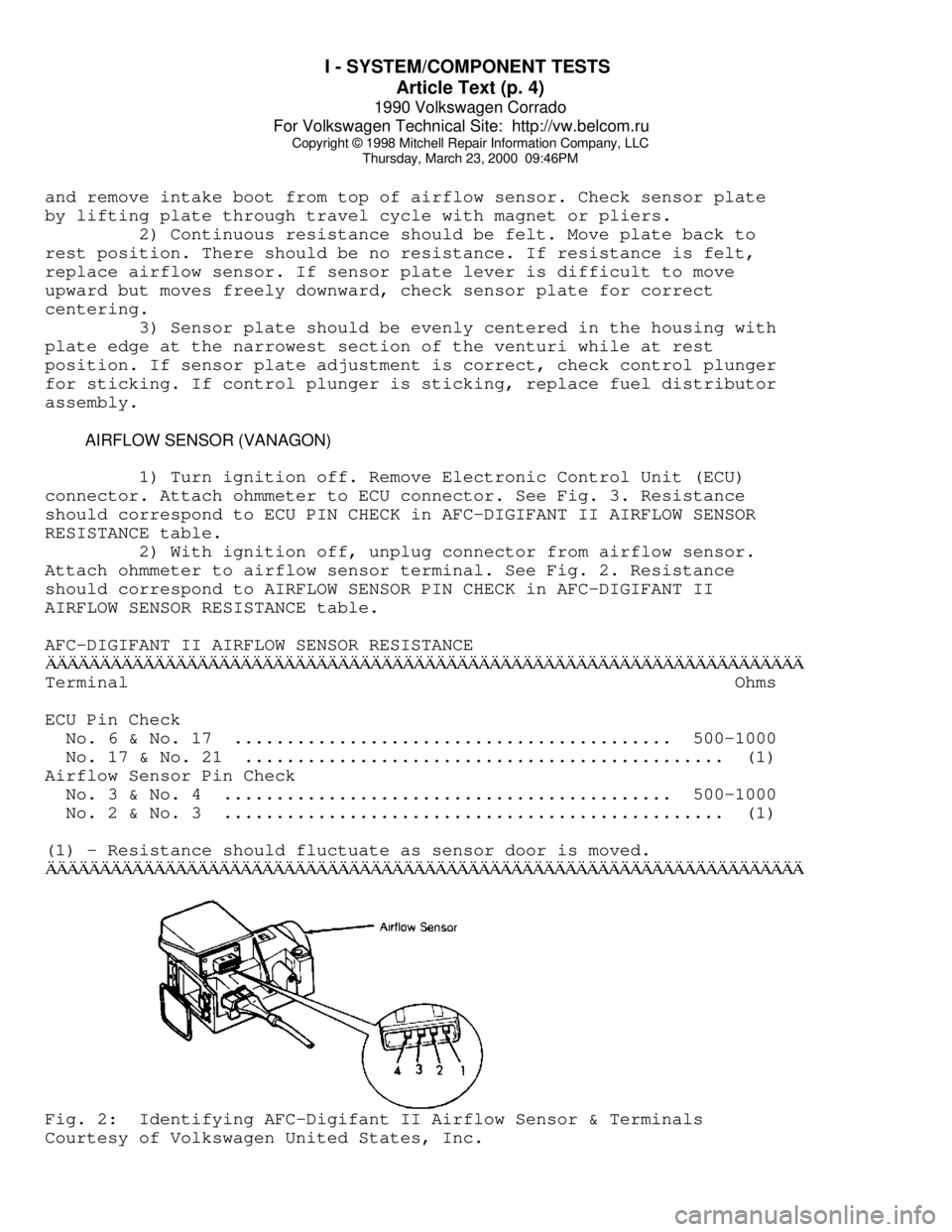
I - SYSTEM/COMPONENT TESTS
Article Text (p. 4)
1990 Volkswagen Corrado
For Volkswagen Technical Site: http://vw.belcom.ru
Copyright © 1998 Mitchell Repair Information Company, LLC
Thursday, March 23, 2000 09:46PM
and remove intake boot from top of airflow sensor. Check sensor plate
by lifting plate through travel cycle with magnet or pliers.
2) Continuous resistance should be felt. Move plate back to
rest position. There should be no resistance. If resistance is felt,
replace airflow sensor. If sensor plate lever is difficult to move
upward but moves freely downward, check sensor plate for correct
centering.
3) Sensor plate should be evenly centered in the housing with
plate edge at the narrowest section of the venturi while at rest
position. If sensor plate adjustment is correct, check control plunger
for sticking. If control plunger is sticking, replace fuel distributor
assembly.
AIRFLOW SENSOR (VANAGON)
1) Turn ignition off. Remove Electronic Control Unit (ECU)
connector. Attach ohmmeter to ECU connector. See Fig. 3. Resistance
should correspond to ECU PIN CHECK in AFC-DIGIFANT II AIRFLOW SENSOR
RESISTANCE table.
2) With ignition off, unplug connector from airflow sensor.
Attach ohmmeter to airflow sensor terminal. See Fig. 2. Resistance
should correspond to AIRFLOW SENSOR PIN CHECK in AFC-DIGIFANT II
AIRFLOW SENSOR RESISTANCE table.
AFC-DIGIFANT II AIRFLOW SENSOR RESISTANCEÄÄÄÄÄÄÄÄÄÄÄÄÄÄÄÄÄÄÄÄÄÄÄÄÄÄÄÄÄÄÄÄÄÄÄÄÄÄÄÄÄÄÄÄÄÄÄÄÄÄÄÄÄÄÄÄÄÄÄÄÄÄÄÄÄÄÄÄÄÄTerminal Ohms
ECU Pin Check
No. 6 & No. 17 .......................................... 500-1000
No. 17 & No. 21 .............................................. (1)
Airflow Sensor Pin Check
No. 3 & No. 4 ........................................... 500-1000
No. 2 & No. 3 ................................................ (1)
(1) - Resistance should fluctuate as sensor door is moved.
ÄÄÄÄÄÄÄÄÄÄÄÄÄÄÄÄÄÄÄÄÄÄÄÄÄÄÄÄÄÄÄÄÄÄÄÄÄÄÄÄÄÄÄÄÄÄÄÄÄÄÄÄÄÄÄÄÄÄÄÄÄÄÄÄÄÄÄÄÄÄFig. 2: Identifying AFC-Digifant II Airflow Sensor & Terminals
Courtesy of Volkswagen United States, Inc.
Page 592 of 906
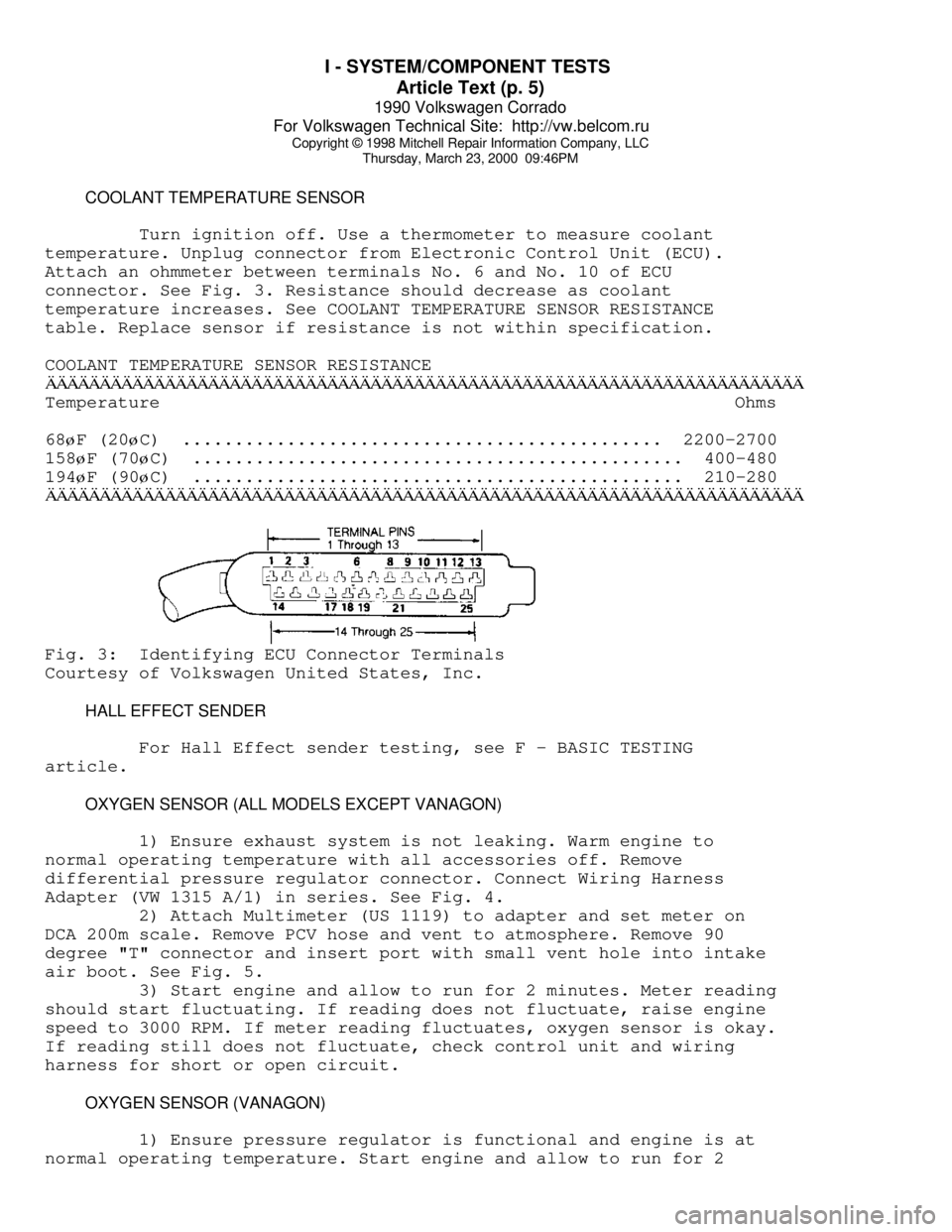
I - SYSTEM/COMPONENT TESTS
Article Text (p. 5)
1990 Volkswagen Corrado
For Volkswagen Technical Site: http://vw.belcom.ru
Copyright © 1998 Mitchell Repair Information Company, LLC
Thursday, March 23, 2000 09:46PM
COOLANT TEMPERATURE SENSOR
Turn ignition off. Use a thermometer to measure coolant
temperature. Unplug connector from Electronic Control Unit (ECU).
Attach an ohmmeter between terminals No. 6 and No. 10 of ECU
connector. See Fig. 3. Resistance should decrease as coolant
temperature increases. See COOLANT TEMPERATURE SENSOR RESISTANCE
table. Replace sensor if resistance is not within specification.
COOLANT TEMPERATURE SENSOR RESISTANCEÄÄÄÄÄÄÄÄÄÄÄÄÄÄÄÄÄÄÄÄÄÄÄÄÄÄÄÄÄÄÄÄÄÄÄÄÄÄÄÄÄÄÄÄÄÄÄÄÄÄÄÄÄÄÄÄÄÄÄÄÄÄÄÄÄÄÄÄÄÄTemperature Ohms
68
øF (20øC) .............................................. 2200-2700
158
øF (70øC) ............................................... 400-480
194
øF (90øC) ............................................... 210-280
ÄÄÄÄÄÄÄÄÄÄÄÄÄÄÄÄÄÄÄÄÄÄÄÄÄÄÄÄÄÄÄÄÄÄÄÄÄÄÄÄÄÄÄÄÄÄÄÄÄÄÄÄÄÄÄÄÄÄÄÄÄÄÄÄÄÄÄÄÄÄFig. 3: Identifying ECU Connector Terminals
Courtesy of Volkswagen United States, Inc.
HALL EFFECT SENDER
For Hall Effect sender testing, see F - BASIC TESTING
article.
OXYGEN SENSOR (ALL MODELS EXCEPT VANAGON)
1) Ensure exhaust system is not leaking. Warm engine to
normal operating temperature with all accessories off. Remove
differential pressure regulator connector. Connect Wiring Harness
Adapter (VW 1315 A/1) in series. See Fig. 4.
2) Attach Multimeter (US 1119) to adapter and set meter on
DCA 200m scale. Remove PCV hose and vent to atmosphere. Remove 90
degree "T" connector and insert port with small vent hole into intake
air boot. See Fig. 5.
3) Start engine and allow to run for 2 minutes. Meter reading
should start fluctuating. If reading does not fluctuate, raise engine
speed to 3000 RPM. If meter reading fluctuates, oxygen sensor is okay.
If reading still does not fluctuate, check control unit and wiring
harness for short or open circuit.
OXYGEN SENSOR (VANAGON)
1) Ensure pressure regulator is functional and engine is at
normal operating temperature. Start engine and allow to run for 2
Page 593 of 906
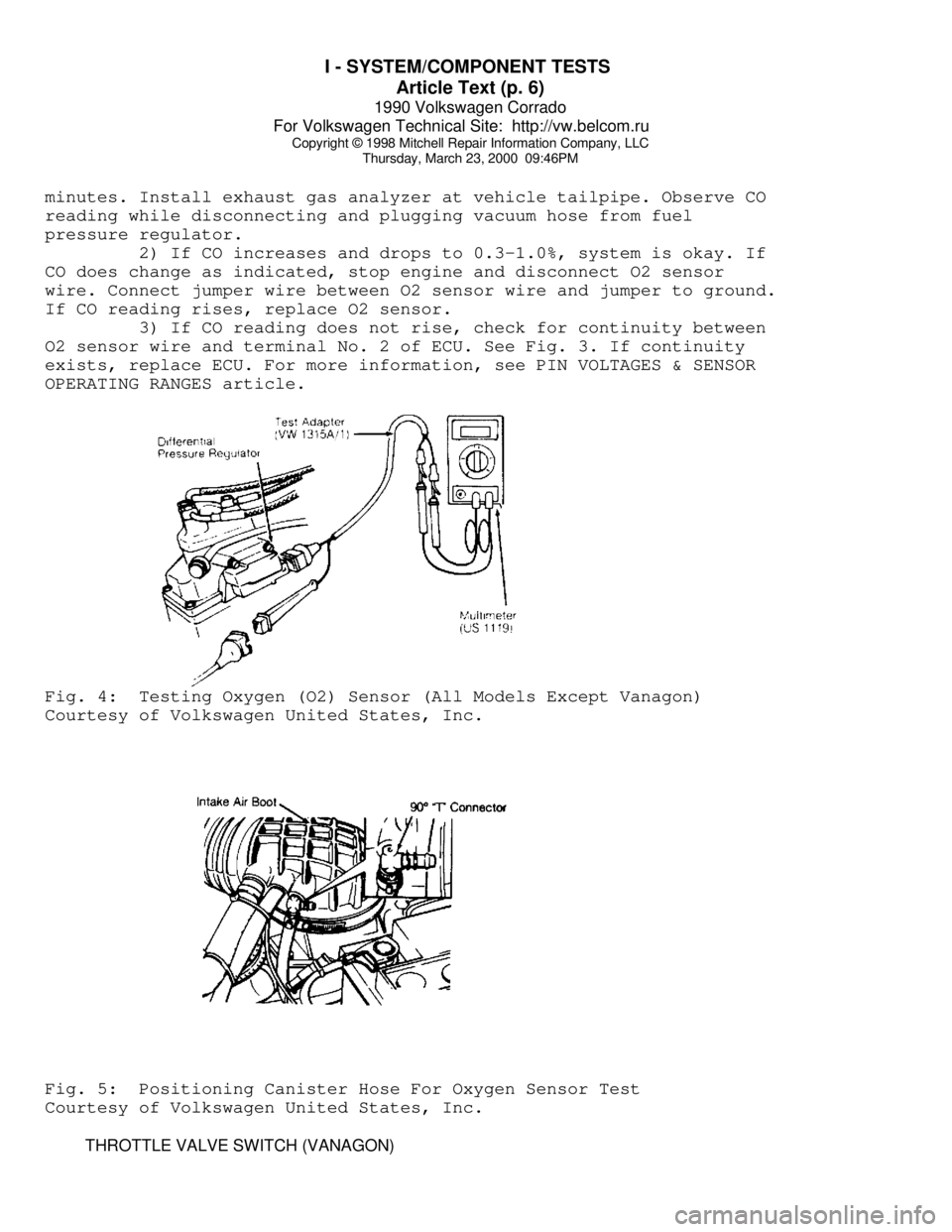
I - SYSTEM/COMPONENT TESTS
Article Text (p. 6)
1990 Volkswagen Corrado
For Volkswagen Technical Site: http://vw.belcom.ru
Copyright © 1998 Mitchell Repair Information Company, LLC
Thursday, March 23, 2000 09:46PM
minutes. Install exhaust gas analyzer at vehicle tailpipe. Observe CO
reading while disconnecting and plugging vacuum hose from fuel
pressure regulator.
2) If CO increases and drops to 0.3-1.0%, system is okay. If
CO does change as indicated, stop engine and disconnect O2 sensor
wire. Connect jumper wire between O2 sensor wire and jumper to ground.
If CO reading rises, replace O2 sensor.
3) If CO reading does not rise, check for continuity between
O2 sensor wire and terminal No. 2 of ECU. See Fig. 3. If continuity
exists, replace ECU. For more information, see PIN VOLTAGES & SENSOR
OPERATING RANGES article.Fig. 4: Testing Oxygen (O2) Sensor (All Models Except Vanagon)
Courtesy of Volkswagen United States, Inc.Fig. 5: Positioning Canister Hose For Oxygen Sensor Test
Courtesy of Volkswagen United States, Inc.
THROTTLE VALVE SWITCH (VANAGON)
Page 598 of 906

I - SYSTEM/COMPONENT TESTS
Article Text (p. 11)
1990 Volkswagen Corrado
For Volkswagen Technical Site: http://vw.belcom.ru
Copyright © 1998 Mitchell Repair Information Company, LLC
Thursday, March 23, 2000 09:46PM
okay, check ground circuit through thermo time switch. Replace thermo
time switch if contact to ground cannot be made.
IDLE CONTROL SYSTEM
NOTE: Knock control is integral in AFC-Digifant II ECU.
KNOCK SENSOR CONTROL UNIT (ALL MODELS EXCEPT VANAGON)
1) Check ignition coil and Hall Effect sender before checking
knock sensor control unit. Remove knock sensor control unit harness
connector. Turn ignition on. Using a voltmeter, check for battery
voltage between terminals No. 3 and No. 5 and terminals No. 6 and No.
3 of knock sensor control unit. Open throttle valve. Voltage should
drop to zero volts.
2) If voltage does not drop to zero volts, check throttle
valve switch (full throttle). Check voltage between terminals No. 8
and No. 3, while fully opening throttle valve. If battery voltage was
not present when throttle fully open, replace throttle valve switch.
See Fig. 13.
3) Remove Hall Effect sender connector and connect voltmeter
to outside terminals. Turn ignition on. There should be 5 volts
present. Turn ignition off. Connect voltmeter between terminals No. 1
(negative) and No. 15 (positive) of ignition coil. Turn ignition on
and touch center terminal of Hall Effect sender briefly to ground.
Voltage should jump momentarily to approximately 2 volts. If voltage
does not jump, replace knock sensor control unit.
KNOCK SENSOR(S)
Before replacing knock sensor, check knock sensor torque and
resistance. Remove knock sensor connector and check resistance between
terminals No. 13 and No. 14. See KNOCK SENSOR TORQUE & RESISTANCE
SPECIFICATION table. If resistance is incorrect, replace knock sensor.
NOTE: Knock sensor mounting bolt torque must be exact. DO NOT use
washers when mounting knock sensor.
KNOCK SENSOR RESISTANCE & TORQUE SPECIFICATIONÄÄÄÄÄÄÄÄÄÄÄÄÄÄÄÄÄÄÄÄÄÄÄÄÄÄÄÄÄÄÄÄÄÄÄÄÄÄÄÄÄÄÄÄÄÄÄÄÄÄÄÄÄÄÄÄÄÄÄÄÄÄÄÄÄÄÄÄÄÄApplication Resistance Ft. Lbs (N.m)
Type I ...................... 300,000 ................ 7-9 (10-12)
Type II .................... Infinite .............. 15-18 (20-25)
ÄÄÄÄÄÄÄÄÄÄÄÄÄÄÄÄÄÄÄÄÄÄÄÄÄÄÄÄÄÄÄÄÄÄÄÄÄÄÄÄÄÄÄÄÄÄÄÄÄÄÄÄÄÄÄÄÄÄÄÄÄÄÄÄÄÄÄÄÄÄ IDLE STABILIZATION SYSTEM (VANAGON)
1) Attach Test Meter (VW 1315/2) and Adapter (US 1119) to
idle stabilization valve. Set meter to milliampere scale. Start
engine. Observe test meter while turning A/C control switch to ON
position. If milliampere reading increases, system is okay.
Page 602 of 906
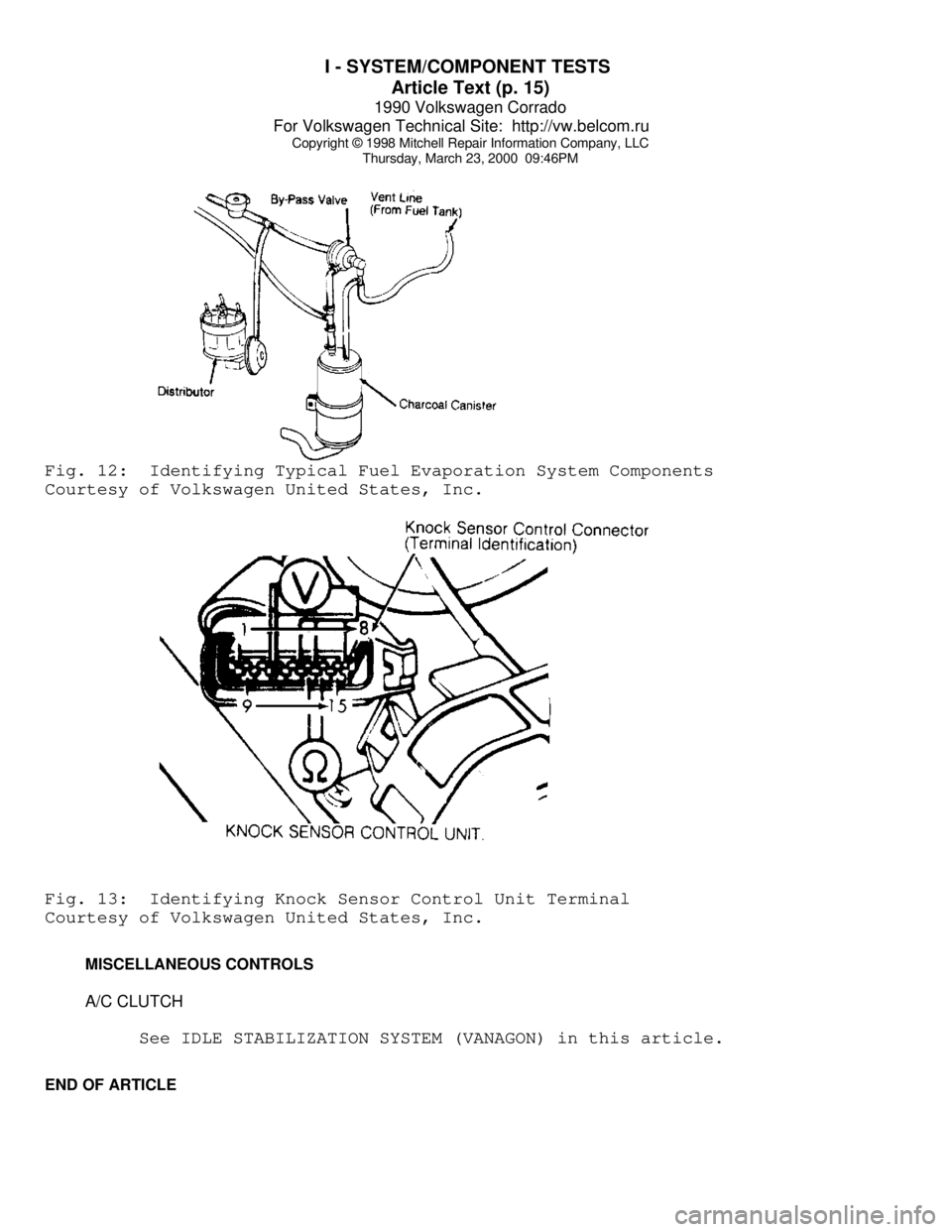
I - SYSTEM/COMPONENT TESTS
Article Text (p. 15)
1990 Volkswagen Corrado
For Volkswagen Technical Site: http://vw.belcom.ru
Copyright © 1998 Mitchell Repair Information Company, LLC
Thursday, March 23, 2000 09:46PMFig. 12: Identifying Typical Fuel Evaporation System Components
Courtesy of Volkswagen United States, Inc.Fig. 13: Identifying Knock Sensor Control Unit Terminal
Courtesy of Volkswagen United States, Inc.
MISCELLANEOUS CONTROLS
A/C CLUTCH
See IDLE STABILIZATION SYSTEM (VANAGON) in this article.
END OF ARTICLE
Page 611 of 906
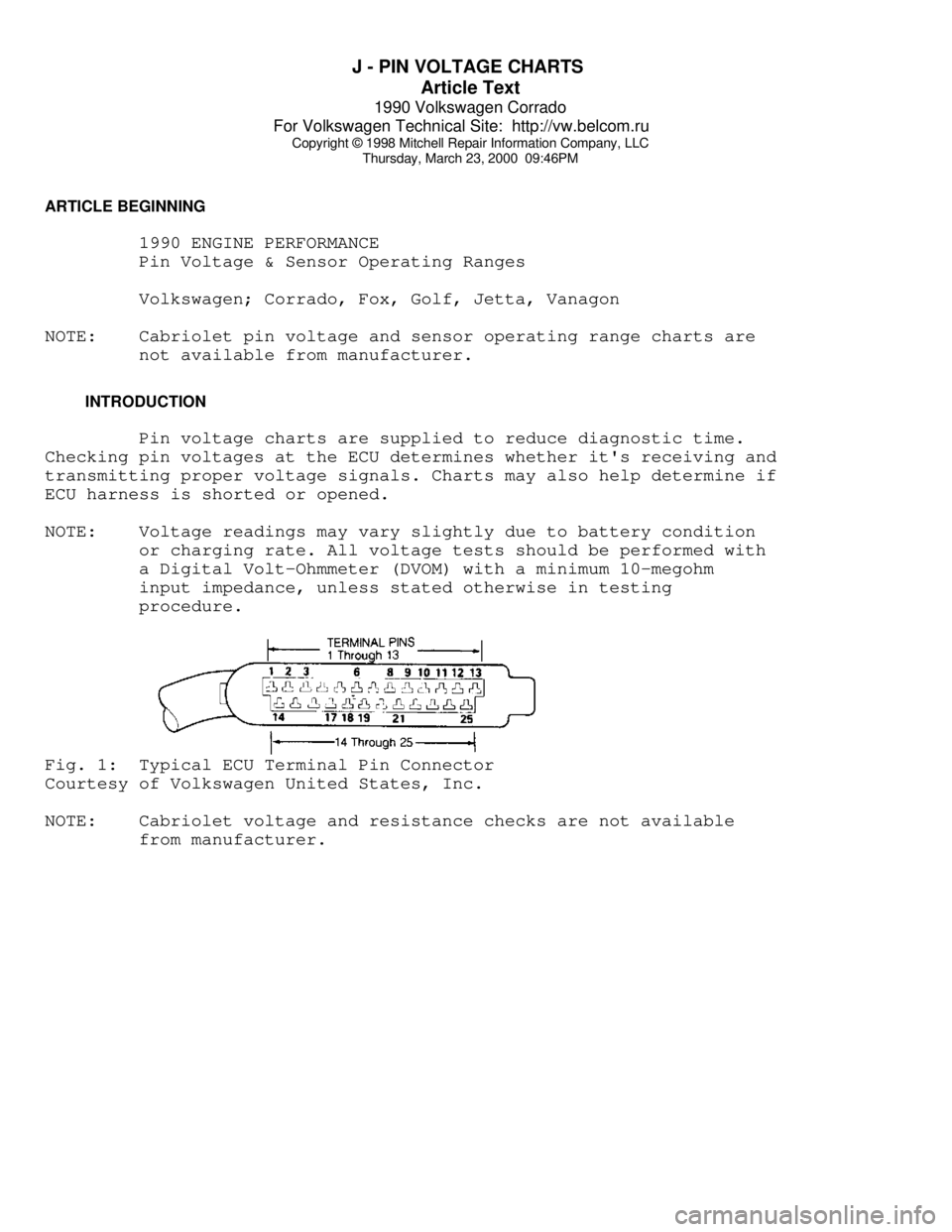
J - PIN VOLTAGE CHARTS
Article Text
1990 Volkswagen Corrado
For Volkswagen Technical Site: http://vw.belcom.ru
Copyright © 1998 Mitchell Repair Information Company, LLC
Thursday, March 23, 2000 09:46PM
ARTICLE BEGINNING
1990 ENGINE PERFORMANCE
Pin Voltage & Sensor Operating Ranges
Volkswagen; Corrado, Fox, Golf, Jetta, Vanagon
NOTE: Cabriolet pin voltage and sensor operating range charts are
not available from manufacturer.
INTRODUCTION
Pin voltage charts are supplied to reduce diagnostic time.
Checking pin voltages at the ECU determines whether it's receiving and
transmitting proper voltage signals. Charts may also help determine if
ECU harness is shorted or opened.
NOTE: Voltage readings may vary slightly due to battery condition
or charging rate. All voltage tests should be performed with
a Digital Volt-Ohmmeter (DVOM) with a minimum 10-megohm
input impedance, unless stated otherwise in testing
procedure.Fig. 1: Typical ECU Terminal Pin Connector
Courtesy of Volkswagen United States, Inc.
NOTE: Cabriolet voltage and resistance checks are not available
from manufacturer.
Page 617 of 906
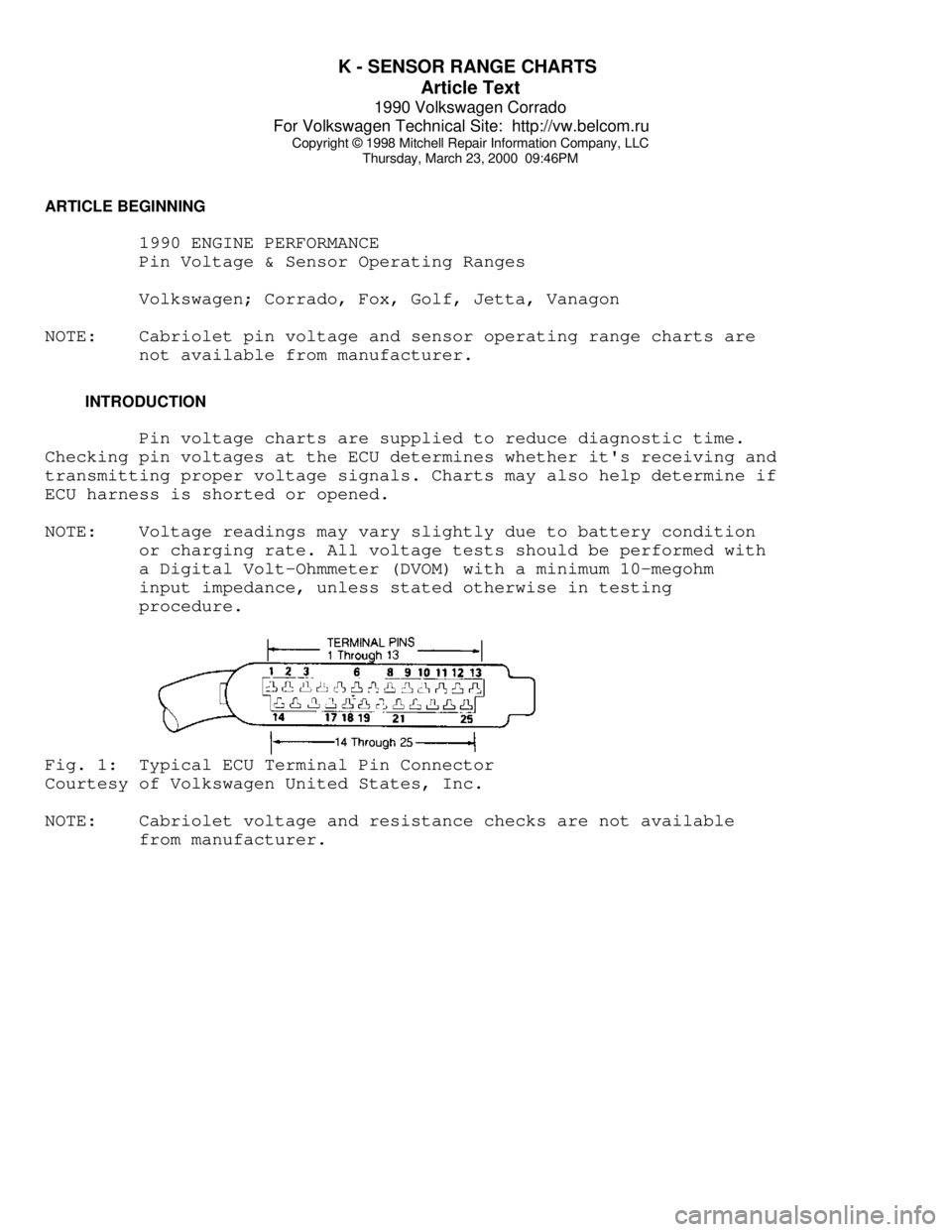
K - SENSOR RANGE CHARTS
Article Text
1990 Volkswagen Corrado
For Volkswagen Technical Site: http://vw.belcom.ru
Copyright © 1998 Mitchell Repair Information Company, LLC
Thursday, March 23, 2000 09:46PM
ARTICLE BEGINNING
1990 ENGINE PERFORMANCE
Pin Voltage & Sensor Operating Ranges
Volkswagen; Corrado, Fox, Golf, Jetta, Vanagon
NOTE: Cabriolet pin voltage and sensor operating range charts are
not available from manufacturer.
INTRODUCTION
Pin voltage charts are supplied to reduce diagnostic time.
Checking pin voltages at the ECU determines whether it's receiving and
transmitting proper voltage signals. Charts may also help determine if
ECU harness is shorted or opened.
NOTE: Voltage readings may vary slightly due to battery condition
or charging rate. All voltage tests should be performed with
a Digital Volt-Ohmmeter (DVOM) with a minimum 10-megohm
input impedance, unless stated otherwise in testing
procedure.Fig. 1: Typical ECU Terminal Pin Connector
Courtesy of Volkswagen United States, Inc.
NOTE: Cabriolet voltage and resistance checks are not available
from manufacturer.